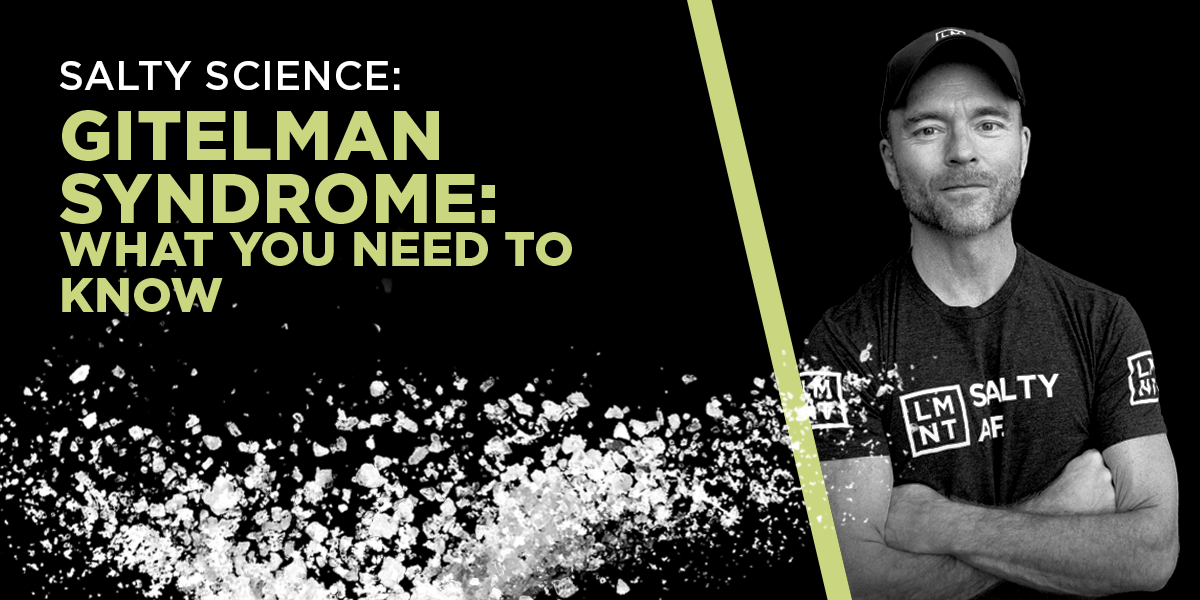Lately, I’ve been reading up on a rare genetic disorder called Gitelman syndrome that is known to cause problems with electrolyte absorption.
When someone has Gitelman syndrome, they often develop low potassium, low magnesium, and low sodium levels. These electrolyte imbalances may lead to a variety of symptoms and health problems.
Many healthy people don’t get enough electrolytes for optimal health, but folks with Gitelman syndrome really need help with electrolytes. Electrolytes like sodium, potassium, and magnesium are the closest thing we have to a cure.
They’re not a true cure though. Gitelman syndrome is a genetic disorder, so those who have it have it for life. There exists the possibility that doctors will be able to modify genes with CRISPR technology in the future, but for now, we have to play the genetic cards we’re dealt.
And when someone gets dealt Gitelman syndrome, they have to work extra hard to maintain electrolyte levels. Why? Because the genetic mutations that define the syndrome impair sodium and magnesium absorption while simultaneously boosting potassium losses.
That’s just a quick summary, folks. If you stick around for five minutes, you’ll learn the symptoms, causes, and treatments for Gitelman syndrome. In the process, you’ll learn some super cool stuff about how the human body works.
What Is Gitelman Syndrome?
Gitelman syndrome, also known as Familial hypokalemia-hypomagnesemia, is a rare genetic disorder caused by mutations in genes that mediate electrolyte absorption. The mutations are typically in the SCL12A3 and the TRPM6 genes.
The consequence of these mutations? An inability to properly absorb sodium, chloride, and magnesium in the kidneys.
I’ll go down that biochemical rabbit hole in a minute, but for now understand that alterations to these pathways lead to a variety of electrolyte disturbances. The most common disturbances are hypokalemia (low serum potassium) and hypomagnesemia (low serum magnesium), though hyponatremia (low serum sodium), hypophosphatemia (low serum phosphate), and hypercalcemia (high serum calcium) have also been reported.[*][*]
The warning signs also show up in the urine. (Urine is where the kidneys dispose of excess electrolytes.) Specifically, those with Gitelman syndrome tend to have high levels of potassium and low levels of calcium (hypocalciuria) in the urine.
Finally, two hormonal hallmarks of Gitelman syndrome are hyperaldosteronism (high aldosterone) and hyperreninism (high renin). Over-activity of these hormones drives heavy potassium losses, often leading to hypokalemia.
Symptoms of Gitelman Syndrome
The symptoms of Gitelman syndrome tie directly to the electrolyte disturbances described above. If the disturbances are mild enough, the person may be asymptomatic.
Let’s start with the symptoms of hypokalemia. They include fatigue, malaise, muscle cramps, and cardiac arrhythmias.
About 60% of people with Gitelman syndrome develop palpitations and 50% have prolonged QTc—an abnormality in how the heart conducts electricity. These disorders may also be related to hypomagnesemia.
Another consequence of low serum magnesium is a neuromuscular disorder called tetany. Tetany is defined by involuntary quakes, shivers, and spasms.
Other symptoms of Gitelman syndrome include:
- Salt cravings and thirst in about 75% of people
- A taste for brine and citrus fruits
- Low blood pressure
- Joint pain
- Paralysis
- A buildup of calcium crystals in the joints (chondrocalcinosis)
- Excess calcium buildup in the kidneys (nephrocalcinosis)
As you can see, the symptoms are fairly diverse. They should be compared with relevant lab testing and genetic testing to make a diagnosis.
What Causes Gitelman Syndrome?
Gitelman syndrome is primarily caused by mutations in two genes:
- SCL12A3
- TRPM6
The mutation in the SCL12A3 gene (thanks for the memorable name people!) disrupts the function of a renal channel called NCCT. What does NCCT do? It helps absorb sodium and chloride through the tubular lumen, the interior of a tube-like structure in the kidneys.
When the NCCT channel doesn’t work properly, you can’t absorb sodium and chloride. That explains the increased salt needs. But the problems with salt absorption also trigger the kidneys to release two sodium retention hormones—aldosterone and renin—that:
- Increase sodium reabsorption
- Increase potassium excretion
This explains the heavy potassium losses and resultant hypokalemia. What about the hypomagnesemia though? That’s where TRPM6 (also the name of my first goldfish) comes in.
The TRPM6 gene codes for a protein that helps magnesium flow into cells. It increases magnesium absorption in the kidneys, intestines, and elsewhere. In Gitelman syndrome, TRPM6 expression is reduced, leading to decreased magnesium absorption, increased magnesium waste, and therefore hypomagnesemia.
Who Does Gitelman Syndrome Affect?
About 25 per 1 million people have Gitelman syndrome, so it’s relatively rare. About 1% of white people, however, are heterozygous for the SCL12A3 genetic mutation—meaning they have one mutated copy of the gene.
If two heterozygous parents make a baby, the baby will have a small chance of developing Gitelman syndrome. If one of the parents is homozygous for the SCL12A3 mutation (i.e., they have Gitelman syndrome), they have a 25% chance of passing it on.
Diagnosing Gitelman Syndrome
Gitelman syndrome can be tricky to diagnose, since many only experience subtle symptoms.
The simplest way to diagnose this condition is through genetic testing. Map your genome using a service like 23andMe, then upload the data into an engine like Promethease. Look up the SCL12A3 and TRPM6 genes to see where you stand.
But since most people still don’t test their genes, the diagnosis is usually made by lab tests, including:
- Serum potassium (looking for hypokalemia)
- Serum magnesium (looking for hypomagnesemia)
- Serum bicarbonate (looking for high levels)
- Serum renin and aldosterone (looking for elevations)
- Urinary calcium (looking for low levels)
Another thing to consider is diuretic and laxative usage. Taking these drugs may increase electrolyte losses and cause similar symptoms to Gitelman syndrome.
Treating Gitelman Syndrome
Because it’s a genetic disorder, there is no cure for Gitelman syndrome. There are, however, strategies to remediate the symptoms.
The main strategy is to consume more electrolytes like potassium, magnesium, and sodium. Let’s spend a moment on each.
Potassium for Gitelman Syndrome
To start, those with Gitelman syndrome should eat plenty of potassium-rich foods like oranges, bananas, green leafy vegetables, salmon, lentils, avocados, and tomatoes. This will help prevent hypokalemia.
Large doses of supplemental potassium may also be helpful. In one case study, a patient taking 3600 mg potassium chloride per day (in three divided doses) showed improvement. Potassium chloride is a good choice because other forms (like potassium gluconate or aspartate) are poorly absorbed.
To prevent potassium waste, a doctor may also prescribe potassium-sparing diuretics or drugs that inhibit the renin-angiotensin system. These drugs should be used cautiously because they can cause hypotension (low blood pressure).
Magnesium for Gitelman Syndrome
Along with potassium, those with Gitelman syndrome should also get their magnesium in check. This means eating green leafy vegetables (magnesium structures the chlorophyll molecule), nuts, avocados, and dark chocolate.
Magnesium supplements are likely useful too, but avoid magnesium oxide and magnesium sulfate. Both forms are poorly absorbed and can cause diarrhea.
A good plan is to take 300 to 500 mg magnesium malate in divided doses throughout the day. The evidence also suggests that slow-release tablets can improve absorption.
Sodium for Gitelman Syndrome
Gitelman syndrome elevates sodium needs. When you can’t absorb sodium properly, you need to consume more of it.
The treatment? Simple: get more salt. Salt provides sodium and chloride, both of which are depleted by Gitelman syndrome.
As a baseline, most folks need about 2–3 teaspoons of salt per day. (That’s around 4–6 grams of sodium.) Those with Gitelman syndrome will need more.
Getting to 4–6 grams sodium and beyond requires aggressive salt shaking—more aggressive than most can manage through diet alone. In my experience, many people (especially active folks) need 1-3 additional grams per day. It’s why we put a full gram of sodium in each stick of LMNT.
I believe LMNT would be helpful for folks with Gitelman syndrome. First of all, there are case studies of supplemental sodium (2.4 supplemental grams per day) improving the symptoms. Plus, LMNT contains 200 mg potassium chloride and 60 mg magnesium malate per stick. Combined with additional potassium supplements, magnesium supplements, an electrolyte-rich diet, and working with a medical professional—you have a decent treatment strategy there.
A Quick Word on Diet
Low carb and ketogenic approaches to diet are likely not the best options for folks with Gitelman Syndrome, since these diets increase our tendency to lose both sodium and potassium.
One last thing before I sign off. If someone you know has this condition, consider forwarding them this article. There aren’t enough resources on Gitelman syndrome out there, so I think the information could really help.

